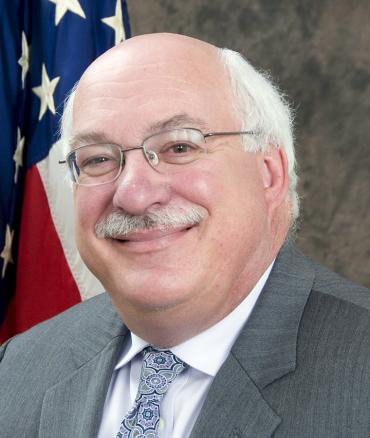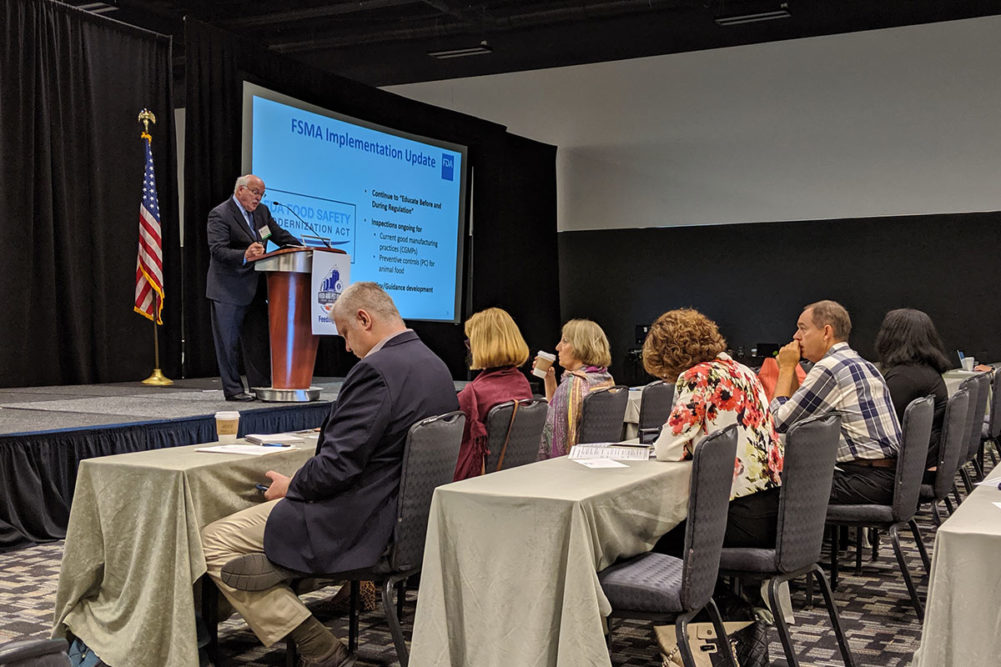KANSAS CITY, Mo. — Dr. Steven Solomon, director of the US Food and Drug Administration’s (FDA) Center for Veterinary Medicine (CVM) presented an update on the agency’s agenda and initiatives in the areas of animal food safety, health and nutrition during the 2019 Feed and Pet Food Joint Conference Sept. 29 to Oct. 2, hosted by Pet Food Institute (PFI) and the National Grain and Feed Association.

Question: Could you share any thoughts from the agency about the notion of establishing a culture of food safety as part of its New Era of Smarter Food Safety initiative?
Solomon: “One of the things things [Frank Yiannas, deputy commissioner for food policy and response, FDA] wrote was a book on food safety culture and the importance of identifying food safety culture. He’s working to make sure that gets done.”
“You can have all the regulations that you want to have, but that doesn’t ensure food safety without helping to address the culture issues that go along with that,” he added.
Solomon said the difference between food safety regulations and a food safety culture are repeated incidents. He referred to the FDA recalling contaminated pig ears back in 1999, which was reflected through an outbreak of Salmonella linked to pet treats just this year. These “repeated” scenarios are inevitable, Solomon suggests, unless we begin having conversations that help to create an inherent culture of food safety in the US.
Question: What is the basis for having a long and sometimes expensive pathway for ingredient approval?
Solomon: “One of the areas that I think the animal food sector has an advantage in is the close-knit community between AAFCO, the states and FDA, making sure we know what all the ingredients are in products… The intent is not to be expensive; we’re trying to improve the timeliness of the process.”
Solomon continued by explaining the FDA continues to push for resources and funding from other industry organization to staff its ingredient review efforts and expedite the process to help processors get to market with new ingredients faster. He said the FDA believes that a review process is crucial even for simple food ingredients because it gives everyone along the value chain peace of mind and confidence in the product.
Question: In going forward with the DCM investigation, how will the agency take actions and address issues mentioned earlier, including controlled feeding trials, sample testing, action studies, ingredient source investigations and ingredient testing?
Solomon: “I think we’re trying to meet with the veterinary community, animal nutritionists, pet food companies and having discussions. We’ve had many of those discussions with PFI; we’re trying to find the right process to engage in those discussions.”
“Feeding trials are probably work that the industry should be doing, we’d love to have that information shared with us,” he added.
Solomon said the suggestions made during his presentation were not necessarily a list of things the FDA was going to do, but that they were suggestions on how the industry, veterinarians and regulatory entities should collaborate to further the science related to the investigation. He cited ongoing collaborations between the FDA and research organizations such as the National Center for Toxicological Research and the Chesapeake Veterinary and Cardiology Association.
“We’re looking to continue to expand the investigation, but I think there are opportunities for others to jump in and then share their scientific information and expertise,” Solomon concluded.
Question: Can you provide any perspectives about the percentage of dogs included in the DCM study that are genetically predisposed to the disease?
Solomon: “We are trying to not include dogs that have a genetic predisposition to dilated cardiomyopathy. Particularly the ones that we do intensive follow-up on are smaller breed dogs, not the giant breed dogs like the Irish wolfhounds and the Doberman pinschers that are predisposed to the genetic form of DCM. We’re looking at animals that traditionally have not been found to have the genetic version.”
“There may be some combination of genetic functions as well as other functions that are related, that’s why this is a complex issue, but we’re trying to target what’s unique about this,” he continued. “In the genetic version, you historically have not seen animals get better… and the version we’re seeing of dilated cardiomyopathy now… shows something around 60% of the animals that have been followed-up [with] have had improvements — some of them quite profound improvements — with dietary change and some with supplementation.”
Solomon also mentioned that the agency suspects there is an underreporting of DCM cases to the FDA, and there are a number of other canine cardiac concerns submitted to the agency that it is not using in the DCM investigation because they do not meet the strict case definition they are using for this particular issue.
Question: In current inspections, is the decision for a comprehensive approach to food safety identified and communicated at the outset of the inspection, or could an inspection become more comprehensive as it goes on?
Solomon: “We’re still in early stages moving on the comprehensive inspections. Some of the FDA inspections are using a more comprehensive approach… But as you also understand, during an inspection process, there may be findings that then suggest a more intensive inspection needs to be done depending on what the findings are. On the state side… we’re just starting to develop the approaches and the thinking of more comprehensive inspections, so right now those inspections are not the more comprehensive inspections.”
Question: Is the CVM engaged in any efforts to further evaluate and characterize the risks of mycotoxins for animal food products, aside from the three existing guidance documents that are currently available?
Solomon: “Aflatoxins is one of those concerns from a hazard that we’re trying to prevent. I think the study of mycotoxins continues to evolve and people are understanding new mycotoxins as times come around… We continue to look at that issue and if additional guidance is needed, we’ll work on that issue.”
Question: How does the agency plan to improve collaboration with industry players and scientists to further animal food safety and animal nutrition?
Solomon: “I think it starts with how we approach the issue. And I think you heard from me that we really want to collaborate. I also recognize it is a tough thing to do, particularly when we’re dealing with sensitive issues, and particularly when you’re dealing with issues about protection of certain information.”
He added, “I’ve seen many outstanding scientific collaborations when we let scientists talk to scientists about issues, but I’m also sensitive to the issue that there could be information shared that individual companies don’t want shared and we want to be able to provide the right protections for them. We also have some challenges. If I’m sharing information with scientists in the industry, I have to share that information with anyone else who asks for it. So, it is a challenging area, but I think it’s one we need to work toward.”
Question: Why didn’t FDA collaborate with brands before releasing names, or providing market share for context, in its latest DCM update?
Solomon: “...We didn’t put the context of individual brand sales because we simply don’t own that information… it’s not data that we had. We did try to put in context… [including] the fact that this represents a signal about a problem and that there is no cause and effect at this point in time. But once again, we do believe that there had to be transparency to alerting the public to what the signal was telling us”
“Listing the products came about because under our freedom of information, when we get reports, they are public information, and people have access to that data,” he said.
For more regulatory news affecting the pet food market, visit our Regulatory page.




